Chernihiv
Chernihiv (Ukrainian: Чернігів, IPA: [tʃerˈn⁽ʲ⁾iɦiu̯]) also known as Chernigov (Russian: Черни́гов, IPA: [tɕɪrˈnʲiɡəf]; Polish: Czernihów, IPA: [tʂɛrˈɲixuf])[lower-alpha 1] is a historic city in northern Ukraine, which serves as the administrative center of the Chernihiv Oblast (province), as well as of the surrounding Chernihiv Raion (district) within the oblast. Administratively, it is incorporated as a city of oblast significance. Population is 288,268 (2019 est.)[3]
Chernihiv Чернігів | |
|---|---|
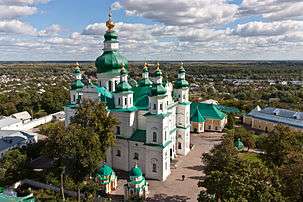  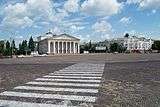 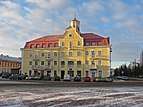 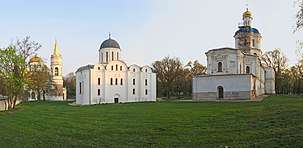 From top, left to right: Trinity Monastery, Catherine's Church, fortress guns on the Val, Krasna Square, Hotel "Desna" building, and view of ancient Chernihiv with Transfiguration, Borys and Hlib Cathedrals and Chernihiv Collegium | |
 Flag 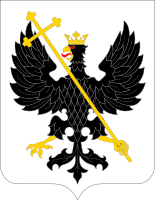 Coat of arms 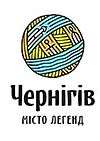 | |
| Nickname(s): City of Legends | |
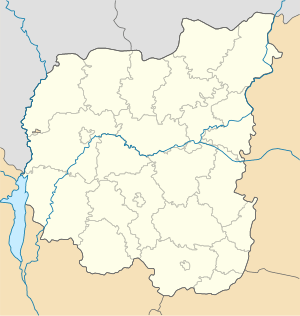 Chernihiv Location of Chernihiv in Ukraine  Chernihiv Chernihiv (Ukraine) | |
| Coordinates: 51°30′0″N 31°18′0″E | |
| Country | |
| Oblast | |
| Municipality | Chernihiv City municipality |
| Founded | 907 |
| City Status | 907 |
| Government | |
| • Mayor | Vladyslav Atroshenko[1] (Petro Poroshenko Bloc "Solidarity"[1]) |
| Area | |
| • Total | 79 km2 (31 sq mi) |
| Elevation | 136 m (446 ft) |
| Population (2019) | |
| • Total | 287 005[2] |
| • Density | 1,547/km2 (4,010/sq mi) |
| Postal code | 14000 |
| Area code(s) | (+380) 462 |
| Vehicle registration | CB / 25 |
| Website | chernigiv-rada.gov.ua |
Geography
Chernihiv stands on the Desna River 150 km to the north-north-east of Kyiv .
The area was served by Chernihiv Shestovitsa Airport, and during the Cold War it was the site of Chernigov air base.
History
Chernihiv was first mentioned in the Rus'–Byzantine Treaty (907) (as Черниговъ (Chernigov)), but the time of establishment is not known. According to the items uncovered by archaeological excavations of a settlement which included artifacts from the Khazar Khaganate, it seems to have existed at least in the 9th century. Towards the end of the 10th century, the city probably had its own rulers. It was there that the Black Grave, one of the largest and earliest royal mounds in Eastern Europe, was excavated in the 19th century.
In the southern portion of the Kievan Rus' the city was the second by importance and wealth.[4] From the early 11th century it was the seat of powerful Grand Principality of Chernigov, whose rulers at times vied for power with Kievan Grand Princes, and often overthrew them and took the primary seat in Kiev for themselves. The grand principality was the largest in Kievan Rus and included not only the Severian towns but even such remote regions as Murom, Ryazan and Tmutarakan. The golden age of Chernihiv, when the city population peaked at 25,000, lasted until 1239 when the city was sacked by the hordes of Batu Khan, which started a long period of relative obscurity.
The area fell under the Grand Duchy of Lithuania in 1353. The city was burned again by Crimean khan Meñli I Giray in 1482 and 1497 and in the 15th to 17th centuries it changed hands several times between Lithuania, Muscovy (1408–1420 and from 1503), and the Polish-Lithuanian Commonwealth (1618–1648), where it was granted Magdeburg rights in 1623 and in 1635 became a seat of Chernihiv Voivodeship. The area's importance increased again in the middle of the 17th century during and after the Khmelnytsky Uprising. In the Hetman State Chernihiv was the city of deployment of Chernihiv Cossack regiment (both a military and territorial unit of the time).
Under the 1667 Treaty of Andrusovo the legal suzerainty of the area was ceded to Tsardom of Russia, with Chernihiv remaining an important center of the autonomous Cossack Hetmanate. With the abolishment of the Hetmanate, the city became an ordinary administrative center of the Russian Empire and a capital of local administrative units. The area in general was ruled by the Governor-General appointed from Saint Petersburg, the imperial capital, and Chernihiv was the capital of local namestnichestvo (province) (from 1782), Malorosiyskaya or Little Russian (from 1797) and Chernigov Governorate (from 1808).
According to the census of 1897, in the city of Chernihiv there were about 11,000 Jews out of the total population of 27,006. Their primary occupations were industrial and commercial. Many tobacco plantations and fruit gardens in the neighborhood were owned by Jews. There were 1,321 Jewish artisans in Chernihiv, including 404 tailors and seamstresses, but the demand for artisan labor was limited to the town. There were 69 Jewish day-laborers, almost exclusively teamsters. But few were engaged in the factories.[5]
During World War II, Chernihiv was occupied by the German Army from 9 September 1941 to 21 September 1943.
The statue of Lenin on Myru Avenue was toppled on February 21, 2014, as part of the demolitions of the statues of Lenin in Ukraine.
Architecture



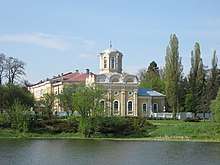
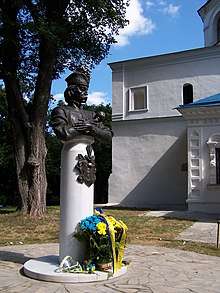
Chernihiv's architectural monuments chronicle the two most flourishing periods in the city's history - those of Kievan Rus' (11th and 12th centuries) and of the Cossack Hetmanate (late 17th and early 18th centuries.)
The oldest church in the city and one of the oldest churches in Ukraine is the 5-domed Transfiguration Cathedral, commissioned in the early 1030s by Mstislav the Bold and completed several decades later by his brother, Yaroslav the Wise. The Cathedral of Sts Boris and Gleb, dating from the mid-12th century, was much rebuilt in succeeding periods, before being restored to its original shape in the 20th century. Likewise built in brick, it has a single dome and six pillars. The crowning achievement of Chernihiv masters was the exquisite Pyatnytska Church, constructed at the turn of the 12th and 13th centuries. This graceful building was seriously damaged in the Second World War; its original medieval outlook was reconstructed to a design by Peter Baranovsky.
The earliest residential buildings in the downtown date from the late 17th century, a period when a Cossack regiment was deployed there. Two most representative residences are those of Polkovnyk Lyzohub (1690s) and Polkovnyk Polubutok (18th century). The former mansion, popularly known as the Mazepa House, used to contain the regiment's chancellery. One of the most profusely decorated Cossack structures is undoubtedly the ecclesiastical collegium, surmounted by a bell-tower (1702). The archbishop's residence was constructed nearby in the 1780s. St Catherine Church (1715), with its 5 gilded pear domes, traditional for Ukrainian architecture, is thought to have been intended as a memorial to the regiment's exploits during the storm of Azov in 1696.
Monasteries
All through the most trying periods of its history, Chernihiv retained its ecclesiastical importance as the seat of bishopric or archbishopric. At the outskirts of the modern city lie two ancient cave monasteries, formerly used as the bishops' residences.
The caves of the Eletsky Monastery are said to predate those of the Kiev Pechersk Lavra (Kiev Monastery of the Caves). Its magnificent 6-pillared cathedral was erected at the turn of the 11th and 12th centuries; some traces of its 750-year-old murals may still be seen in the interior. After the domes collapsed in 1611, they were augmented and reconstructed in the Ukrainian baroque style. The wall, monastic cells, and bell-tower all date from the 17th century. The nearby mother superior's house is thought to be the oldest residential building in the Left-Bank Ukraine. The cloister's holiest icon used to be that of Theotokos, who made her epiphany to Svyatoslav of Chernigov on 6 February 1060. The icon, called Eletskaya after the fir wood it was painted upon, was taken to Moscow by Svyatoslav's descendants, the Baryatinsky family, in 1579.
The nearby Chernihiv Glory Memorial we can find Saint Anthony Caves of Saint Elijah and the Holy Trinity features a small eponymous church, which was constructed 800 years ago. The roomy Trinity cathedral, one of the most imposing monuments of the Cossack baroque, was erected between 1679 and 1689. Its refectory, with the adjoining church of Presentation to the Temple, was finished by 1679. There are also the 17th-century towered walls, monastic cells, and the five-tiered belfry from the 1780s.
Other historic abbeys may be visited in the vicinity of Chernihiv; those in Kozelets and Hustynya contain superb samples of Ukrainian national architecture.
Transport
Train

Chernihiv has a nice train station with bus station called Chernihiv Ovruch railway. Narrow gauge railway of 76 versts was laid from the Kruty station of the Moscow Kiev-Voronezh railway towards Chernihiv. In 1893, on the left bank of the Desna River, in the area of a modern automobile bridge, a railway station was built along the Kiev highway. Passengers were delivered here from the city and back by horse transport. In 1925, traffic was opened on the Nizhyn - Chernigov section of the Southwest Railway. But the appearance of railway transport in Chernihiv was postponed until 1928 (the bridge over the Desna River was not ready and the trains still arrived on the left bank, where the old narrow-gauge railway station was located, from where passengers got to Chernihiv by road bridge). According to 2006 data, the volume of freight traffic is 84,737 wagons per year. Over 4.5 million passengers are transported each year. However, the condition of the rolling stock and the quality of the services provided do not meet modern requirements. Since the introduction of the new high-speed train timetable, the trailed wagons of the 93/94 Chernigov - Odessa train were canceled. As of 2015, regular trains Minsk - Odessa, St. Petersburg - Kiev / Kharkov run through Chernihiv, and there are direct connections with Moscow. Trains to Crimea (Simferopol, Feodosia) were canceled from December 27, 2014.
Air transport
The area was served by Chernihiv Shestovitsa Airport, and during the Cold War it was the site of Chernigov air base. The close airport is in Kiev at the Boryspil Airport located 143.1 kilometres (89 miles) away, and the smaller, municipally owned Zhulyany Airport located 158.7 km away on the southern outskirts of the city of Kiev.
Bus
The best way here from Kyiv is on a marshrutka from Lisova metro station (100uah, two hours, around every 30 minutes), which drop off outside McDonald's (on pr Pobedy). Buses for Novhorod-Siversky leave hourly from Chernihiv's Central bus station (65uah, three hours), located near the Chernihiv train station.
Local public transport
Public transport includes buses and trolleybuses. There is no direct connection between railway station and Chernihiv-1 bus station to the most central sights on the Val - you will have to take any trolleybus or bus from the station to crossing of Prospekt Mira and Prospekt Pobedy (Hotel Ukraine stop; look for the end of the boulevard along Prospekt Mira near it), and than walk through historical centre a little. Trolleybus 1 and bus 38 will take you even one stop further, to Drama Theater stop near Pyatnickaya church, but no further. Consult map, as different routes come to Hotel "Ukraine" from different sides, you will have to walk along Prospekt Mira along its continuation after boulevard ends.
Sports & Facilities
FC Desna Chernhiv

The main Football club of Chernihiv is called FC Desna Chernihiv, the original name of the club was "Avanhard Chernihiv" during its first year of existence. Between 1961–70 the club was called Desna. In 1972 it was replaced with SC Chernihiv (team of the SKA Kiev) that played in Chernihiv for the next couple of years. In 1977 Desna was revived now in place of the amateur club "Khimik Cherhihiv" that won regional competitions. On 27 May 2018, the team got promoted to the Ukrainian Premier League for the first time in their history. The original team colours were blue shirts, blue shorts, blue socks. The team got into the Quarterfinals of the Ukrainian Cup in the season 2017-18 against Dynamo Kyiv. The club and during the season 2019-20 got again into the Quarterfinals of the Ukrainian Cup for the second time of the history of the club. In Premier League in the season 2019–20, Desna got into the play-offs for the Championship round table and qualified mathematically at least for the Europa League third qualifying round, for the first time in the history of the Club since 1960.[6]
Desna 2
FC Desna-2 Chernihiv is the Reserve or 2nd squad of FC Desna Chernihiv, that play mainly in Stadion Yuri Gagarin and sometimes in Chernihiv Arena (Lokomotiv Stadium).
FC Chernihiv
FC Chernihiv is another club in the city of Chernihiv, founded in 2003, which they play in Chernihiv Arena (Lokomotiv Stadium).
Desna Youth Academy
Desna Chernihiv FC Youth Academy[7] is the Youth Academy of the Desna Club playing in Stadion Yuri Gagarin.
Stadion Yuri Gagarin & Chernihiv Arena

The Club of FC Desna Chernihiv played at the Olympic sports training center "Chernihiv" (formerly Stadion Yuriya Gagarina). The Stadion Yuri Gagarin in Chernihiv and it was built in 1936 for 3,000 spectators in eastern portion of a city park (garden) that exists since 1804 and where previously was located residence of the Chernihiv Archbishops.
The city of Chernihiv has also another sport complex called Chernihiv Arena (Lokomotiv Stadium) in Kil'tseva St, 2а, Chernihiv, Chernihiv Oblast, Ukraine, 14039.
Rivers in Chernihiv
Desna River
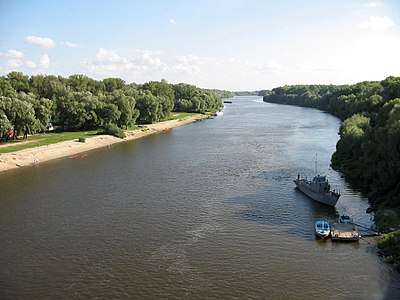
The city of Chernihiv is crossed by Desna River which is a river in Russia and Ukraine, a major left tributary of the Dnieper river. The word means "right hand" in the Old East Slavic language. Its length is 1,130 km (702 mi), and its drainage basin covers 88,900 km2 (34,324 sq mi).
In Ukraine, the river's width ranges from 60 to 250 metres (200 to 820 ft), with its average depth being 3 m (10 ft). The mean annual discharge at its mouth is 360 m3/s (13,000 cu ft/s). The river freezes over from early December to early April, and is navigable from Novhorod-Siverskyi to its mouth, which totals about 535 km (332 mi).
Snov River
_-_1.jpg)
Chernihiv has also The Snov river in Bryansk Oblast in Russia and Chernihiv Oblast in Ukraine, right tributary of the Desna River (Dnieper's basin). The length of the river is 253 km. The area of its drainage basin is 8,700 km2.The Snov freezes up in November - late January and stays icebound until March - early April. Part of the river forms the Russia–Ukraine border.
According to Ruthenian chronicles, in 1068 at Snov River took place a battle between Duke of Chernihiv Sviatoslav Yaroslavich and Cumans led by their Duke Sharukan.
Climate
Chernihiv has a humid continental climate (Köppen Dfb) with cold, cloudy and snowy winters, and warm, sunny summers. The average annual temperature for Chernihiv is 7.0 °C (44.6 °F), ranging from a low of −5.6 °C (21.9 °F) in January to a high of 19.5 °C (67.1 °F) in July. Precipitation is well distributed throughout the year though precipitation is higher during the summer months and lower during the winter months. The record high was 39.0 °C (102.2 °F) and the record low was −36.0 °C (−32.8 °F).
| Climate data for Chernihiv | |||||||||||||
|---|---|---|---|---|---|---|---|---|---|---|---|---|---|
| Month | Jan | Feb | Mar | Apr | May | Jun | Jul | Aug | Sep | Oct | Nov | Dec | Year |
| Record high °C (°F) | 9.6 (49.3) |
16.2 (61.2) |
22.3 (72.1) |
28.9 (84.0) |
33.5 (92.3) |
39.0 (102.2) |
38.9 (102.0) |
38.0 (100.4) |
32.6 (90.7) |
27.8 (82.0) |
18.4 (65.1) |
14.0 (57.2) |
39.0 (102.2) |
| Average high °C (°F) | −3.1 (26.4) |
−1.9 (28.6) |
3.8 (38.8) |
13.0 (55.4) |
20.0 (68.0) |
23.3 (73.9) |
25.2 (77.4) |
24.3 (75.7) |
18.5 (65.3) |
11.5 (52.7) |
3.8 (38.8) |
−1.2 (29.8) |
11.4 (52.6) |
| Daily mean °C (°F) | −5.6 (21.9) |
−4.9 (23.2) |
−0.1 (31.8) |
8.0 (46.4) |
14.4 (57.9) |
17.8 (64.0) |
19.5 (67.1) |
18.4 (65.1) |
12.9 (55.2) |
6.9 (44.4) |
1.0 (33.8) |
−3.4 (25.9) |
7.1 (44.7) |
| Average low °C (°F) | −8.7 (16.3) |
−8.2 (17.2) |
−3.7 (25.3) |
3.3 (37.9) |
8.9 (48.0) |
12.4 (54.3) |
14.2 (57.6) |
13.1 (55.6) |
8.0 (46.4) |
2.9 (37.2) |
−1.6 (29.1) |
−6.1 (21.0) |
2.9 (37.2) |
| Record low °C (°F) | −36 (−33) |
−33.9 (−29.0) |
−29.9 (−21.8) |
−13.9 (7.0) |
−2.2 (28.0) |
1.1 (34.0) |
3.9 (39.0) |
2.0 (35.6) |
−4.3 (24.3) |
−10.8 (12.6) |
−23.5 (−10.3) |
−28 (−18) |
−36 (−33) |
| Average precipitation mm (inches) | 41.2 (1.62) |
35.1 (1.38) |
35.5 (1.40) |
44.4 (1.75) |
50.8 (2.00) |
82.9 (3.26) |
83.8 (3.30) |
66.2 (2.61) |
58.4 (2.30) |
38.8 (1.53) |
45.6 (1.80) |
45.5 (1.79) |
628.2 (24.73) |
| Average precipitation days | 20.4 | 17.9 | 14.6 | 11.1 | 10.2 | 10.4 | 8.2 | 8.6 | 9.5 | 11.4 | 15.8 | 19.7 | 157.8 |
| Average snowy days | 16 | 13 | 8 | 2 | 0 | 0 | 0 | 0 | 0 | 2 | 8 | 15 | 64 |
| Average relative humidity (%) | 85.5 | 81.6 | 75.1 | 64.0 | 63.3 | 66.7 | 68.6 | 68.4 | 74.8 | 80.4 | 87.3 | 88.0 | 75.3 |
| Mean monthly sunshine hours | 49.6 | 70.0 | 127.1 | 201.0 | 279.0 | 285.0 | 303.8 | 275.9 | 183.0 | 120.9 | 36.0 | 34.1 | 1,965.4 |
| Source 1: Climatebase.ru[8] | |||||||||||||
| Source 2: Weatherbase[9] | |||||||||||||
Gallery
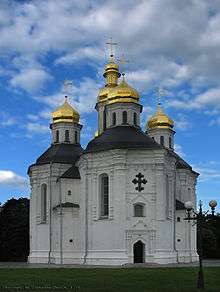
 The Pyatnytska Church Friday (c. 1201, restored after World War II).
The Pyatnytska Church Friday (c. 1201, restored after World War II)..jpg) Church of the Archangel Michael
Church of the Archangel Michael Dytynets Park
Dytynets Park Boldina gora
Boldina gora Krasna Square and Shevchenko Theatre
Krasna Square and Shevchenko Theatre
- Opera and Drama Theatre, designed by Semyon Fridlin
- Shchors cinema in Chernihiv
- Hotel Desna
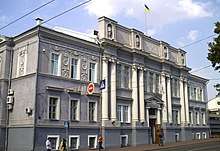
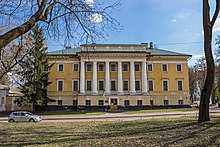
- Mykhailo Kotsiubynskyi Museum
- Tarnovsky Museum of antiquities
 Chernihiv architecture
Chernihiv architecture Old and modern buildings
Old and modern buildings New apartment block
New apartment block City hospital
City hospital Chernihiv philharmony
Chernihiv philharmony Wedding Palace
Wedding Palace
 Desna River
Desna River_-_1.jpg) Snov river
Snov river
Notable people
- Yukhym Shkolnykov, Ukrainian coach and Soviet footballer, from Chernihiv, played for the team Avanhard Chernihiv that in 1960.
- Jacob Tamarkin, Russian-American mathematician born in Chernihiv
- Denys Skepskyi Ukrainian footballer born in Chernihiv
- Dmytro Zaderetskyi Ukrainian footballer born in Chernihiv
- Anatoly Rybakov, Russian writer
- Nikolai Fedorovich Drozdov, scientist and Red Army general
- Vladimir Antonov-Ovseenko, Soviet Bolshevik leader and diplomat
- Vadim Pruzhanov, keyboardist for the Extreme Power Metal band DragonForce
- Giennadij Jerszow, Polish-Ukrainian sculptor born in Chernihiv
- Eduard Weitz (born 1946), Israeli Olympic weightlifter
- Andriy Yarmolenko, Ukrainian footballer raised in Chernihiv who played for FC Desna Chernihiv, FC Dynamo Kyiv, Borussia Dortmund and now plays for West Ham United F.C.
- Andriy Fedorenko, Ukrainian footballer goalkeeper born in Chernihiv
- Denys Bezborodko, Ukrainian footballer born in Chernihiv, played for Shakhtar-3 Donetsk
- Yuriy Hruznov, Ukrainian footballer goalkeeper and coach born in Chernihiv, played for FC Desna Chernihiv
- Vitaliy Havrysh, Ukrainian footballer born in Chernihiv, played for FC Desna Chernihiv
- Oleh Lyashko, Ukrainian politician, member of Verhovna Rada and leader of Radical Party of Oleh Lyashko.
- Andriy Protsko, Ukrainian footballer born in Chernihiv, who got the most caps for FC Desna Chernihiv
International relations
Twin towns - Sister cities
Chernihiv is currently twinned with:







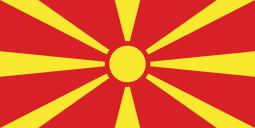
Footnotes
- Other English renditions of Чернигов include Tchernigov, Tschernigow, Tschernigov, Chernigiv and Chernigow.
Bibliography
- Ocherk istorii goroda Chernigova 907–1907 gg. (Chernihiv 1908)
- Hrushevs'kyi, M. (ed). Chernihiv i Pivnichne Livoberezhzhia (Kyiv 1928)
- Martin Dimnik. The Dynasty of Chernigov, 1146-1246.
- Rybakov, B. Drevnosti Chernigova (Moscow 1949)
- Ignatkin, I. Chernigov (Kyiv 1955)
- Iedomakha, I. Chernihiv (Kyiv 1958)
- Logvin, G.N. (Г. Н. Логвин) (1965). Chernigov, Novgorod-Seversky, Glukhov, Putivl (Чернигов, Новгород-Северский, Глухов, Путивль) (in Russian). Moscow.
- Asieiev, Iu. Arkhitektura Kyïvs'koï Rusi (Kyiv 1969)
- Karnabida, A. Chernihiv. Istorychno-arkhitekturnyi narys (Kyiv 1969)
- (1972) Історіа міст і сіл Української CCP - Чернігівська область (History of Towns and Villages of the Ukrainian SSR - Chernihiv Oblast), Kiev. (in Ukrainian)
- Asieiev, Iu. Dzherela. Mystetstvo Kyïvs'koï Rusi (Kyiv 1980)
- Pyotr Rappoport (П. А. Раппопорт) (1993). Ancient Russian Architecture (Древнерусская архитектура) (in Russian). Saint-Petersburg.
Notes
- Poroshenko Bloc's Atroshenko wins Chernihiv mayoral election – Central Election Commission, Interfax-Ukraine (18 November 2015)
- Чисельність населення (за оцінкою) на 1 грудня 2019 року // Головне управління статистики у Чернігівській області
- "Чисельність наявного населення України (Actual population of Ukraine)" (PDF) (in Ukrainian). State Statistics Service of Ukraine. Retrieved 23 May 2020.
- Nasledie Svyatoy Rusi Archived 2018-04-02 at the Wayback Machine URL accessed on January 12, 2006
- jewishencyclopedia.com Copy from 12-volume Jewish Encyclopedia, which was originally published between 1901-1906.
- "FC Desna Chernihiv qualified for the Europa League for the first time since 1960". thetimeshub.in. Retrieved 9 July 2020.
- "Desna Chernihiv FC Youth Academy". www.facebook.com/fcdesnaacademy/. Retrieved 21 June 2020.
- "Climate Data for Chernihiv, Ukraine 1949-2011". Climatebase. Retrieved March 1, 2013.
- "Weatherbase: Historical Weather for Chernihiv, Ukraine". Weatherbase. Retrieved March 1, 2013.
- "Tarnobrzeg Official Website - Partner Cities".

External links
- Chernihiv City Portal
- chernigiv-rada.gov.ua — Official webportal of the Chernihiv City Rada (in Ukrainian and English)
- Chernihiv guide
- Chernihiv in the Encyclopedia of Ukraine
- "Chernigov-Gethsemane" Icon of the Mother of God. Russian Orthodox Cathedral of St. John the Baptist, Washington DC. (ROCOR).
- Chernihiv Sketch Map — Sketch Map of Chernihiv
- Chernihiv souvenirs — Chernihiv Gifts and Souvenirs
- History of Jewish Community in Chernigov
- The murder of the Jews of Chernihiv during World War II, at Yad Vashem website.

